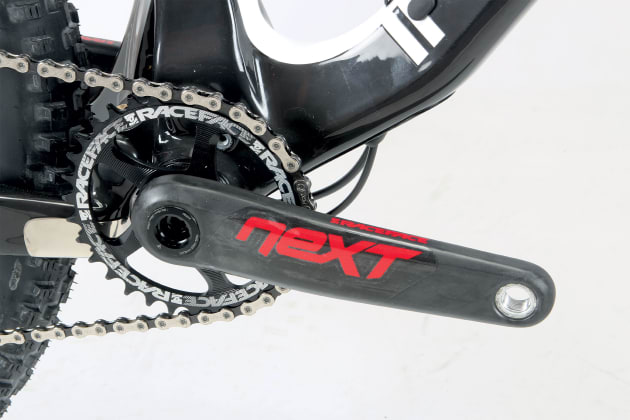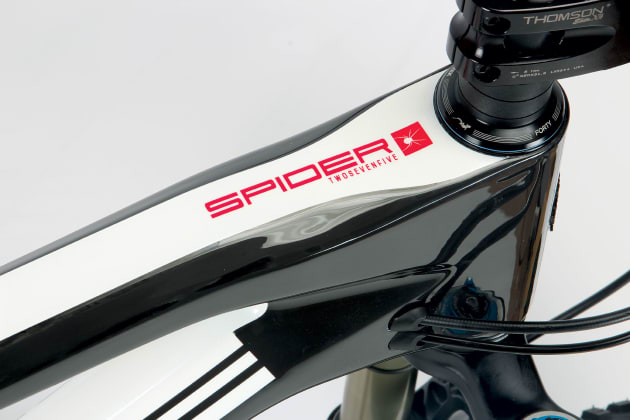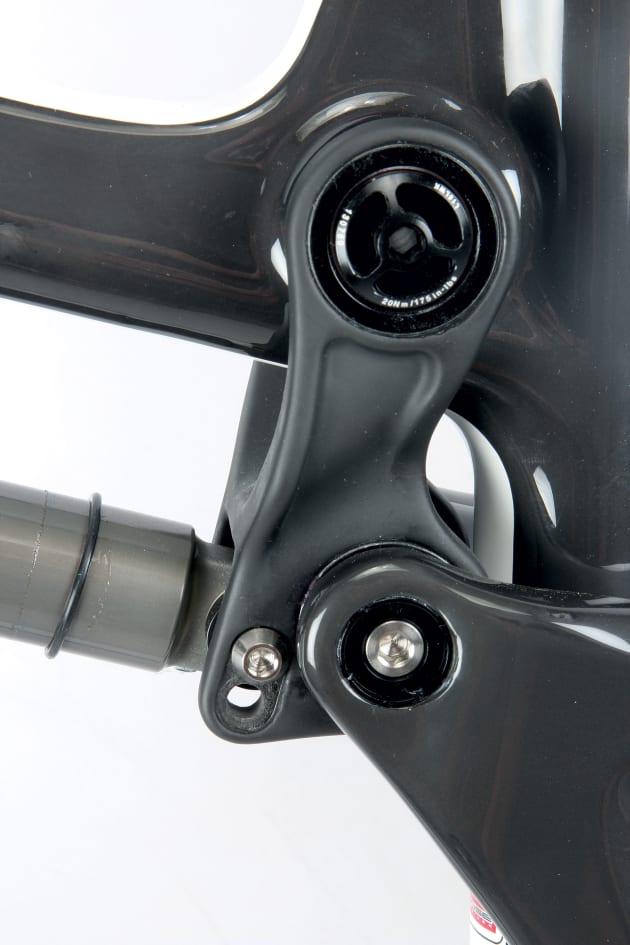Intense Spider 275c
Currently there’s no shortage of great mountain bikes on the market. Frame geometry, suspension designs and manufacturing techniques continue to improve to the point where it’s getting harder and harder to buy a dud. These days finding the ideal bike is more about matching the ride characteristics to your particular needs and desires.
Despite the increased competition, certain brands manage to retain an aura of sorts. Names like Santa Cruz and Yeti still provoke excitement and desire from any full-blooded mountain biker, and Intense Cycles definitely sits in that league. The brand has been around since the early ‘90s and many of the world’s best have ridden them; John Tomac, Shaun Palmer, Gee Atherton, Greg Minnaar, Mick Hannah, Chris Kovarik and more. In many cases their bikes were relabelled due to sponsorship commitments, but these legends rode Intense by choice.
Jeff Steber remains the main man behind Intense Cycles and the Spider (spelt Spyder at the time) was his very first suspension bike. Built it at his Californian home in 1993, the Spider was a cross-country bike with 75mm of travel. It didn’t take off with XC riders as it was deemed to have too much travel, however the downhillers loved it.

For the first couple of decades Intense built all of their frames in the US but more recently, with the introduction of various carbon fibre models, production has moved to Asia. Still, Intense remains quite proud that some of their alloy bikes are still welded together in the good ol’ US of A. Our Spider 275c is all carbon however, and it represents the new generation of Intense bikes.
Pay to Play
While they have a big reputation, Intense remains a relatively small boutique brand and the cost of entry ensures that you won’t see many of them on your local trails. The Spider 275c frame sells for $4,699; that’s enough to buy a ready-to-ride carbon dually in many brands! With a no-expense-spared ‘Factory’ build, the Spider retails for $13,799; that gets you DT Swiss XCM 1200 carbon wheels, Renthal carbon bars, a SRAM XX1 drivetrain and Race Face NEXT carbon cranks.
Ours was the next in line Spider Pro. For $9,799 the bike has the same SL carbon frame but it’s fitted with alloy DT M1700 wheels and the Fox Factory Kashima suspension is swapped out for a Performance level shock and fork. SRAM X1 triggers combine with an X01 derailleur while the 11-speed cassette drops down to a GX level unit. At least it retains the big-ticket Race Face NEXT cranks at this price point.

The remainder of the spec has no shortage of quality bits; a KS Lev dropper, Italian Fabric saddle, Thomson stem, Renthal alloy bar, Cane Creek 40 headset, Evolution series Schwalbe tyres and so on. Yes it’s good gear that you don’t need to change, but so it should be for almost $10K.
Before I get too disgruntled about the asking price, it’s worth pointing out that you'll be looking at similar money for a CC level Santa Cruz, a Yeti SB or an Ibis Mojo 3 frame. While the build kit options vary from brand to brand, the spec of our Spider Pro isn’t radically different from what you’ll see on other boutique brands at the same price.
If your budget doesn’t stretch to the Pro build, Intense offers two more ‘affordable’ options. The $8,599 Expert build runs Shimano XT 11-speed with alloy Race Face cranks, DT M1900 wheels and RockShox suspension while the $6,699 Foundation build is mainly SRAM GX with Sun Helix rims. Both of these lower models use a slightly heavier version of the Spider carbon frame.
With the premium pricing you’d want a premium quality bike, and thankfully Intense delivers with a beautifully finished frame. Many brands offer carbon bikes with a better parts for fewer dollars but they usually run an alloy rear end. In this case both the front and rear triangles are made entirely from high modulus carbon. Even the upper suspension link is carbon and the whole thing is fitted out with titanium hardware.

Our medium frame weighed 2,670g including the shock. That’s a hundred grams or so heavier than a Yeti SB5 or an Ibis Mojo 3, and roughly the same as the Santa Cruz 5010—competitive enough for a 130mm travel all-rounder. You’ll find the same ‘SL’ frame on the Pro and Factory models but the Expert and Foundation builds use a frame that’s 250-300g heavier. The more affordable Spider runs an alloy upper link, stainless steel hardware and mid-modulus carbon, which means a little extra material is added to maintain the same strength and stiffness. If you’re undertaking a ground-up build, the SL version is the only one that’s offered as a frame kit.
As with many new bikes, the Spider uses wider ‘boost’ spacing for the hubs and cranks—it’s the first Intense to utilise this setup. Boost pushes drivetrain outboard and provides extra tyre clearance. In this case the added clearance has been used to pull the rear wheel in closer to the bottom bracket—the result is an impressively short 419mm chainstay.
Internal cabling features throughout with two inlet ports on each side of the head tube. This allows for clean, rub-free cable routing with virtually any cockpit setup. While the cable routing flexibility is great, the lack of any guide tubes inside the frame means the cables can rattle if they’re not pulled taut. As the rubber frame grommets don’t lock tightly onto the cables, a little customisation is needed to secure the outer housing where it enters the frame; some strategically placed zip ties just next to the grommet will do the trick. The frame ports aren’t particularly large either, so cable replacement is best tackled by piggybacking off the old casing to pull the new one through.

Where many new generation bikes eschew front derailleur compatibility to gain super short chainstays, the Spider retains a high-mount tab that lets you run a double chainring if needed. All of the build options are 1X11 though, which should keep most Aussie mountain bikers happy. There are ISCG 05 tabs around the bottom bracket, so you’ll have no shortage of options when it comes to fitting a chain guide.
Like front derailleurs, water bottles are often forgotten these days but the Spider caters for old school hydration techniques too. Clearance is tight though, so it’s best to use a low-slung side mount cage—even then we still only had room for a smallish bottle on our medium frame.
The Spider comes with neatly formed rubber protectors on the chainstay and under the down tube, although the down tube protector doesn’t extend very far up the frame (it’s barely worth having). There’s a steel plate at the front of the chainstay too; it’s well executed and should limit the chance of chain/chainring related frame damage.
On older generation VPP equipped Intense bikes, the lower suspension link used to hang down below the bottom bracket. This made it more vulnerable and prone to copping rock strikes. With newer models like the Spider 275 and Tracer, the link is tucked up and out of the way. The lower link also incorporates two grease ports that make it easy to keep the bearings running smoothly. It’s a wise inclusion as this part is right in the line of fire for mud off the back wheel—just make sure you thoroughly clean the ports before greasing so you don’t force dirt into the bearings.
Moving rearwards, the full carbon swingarm has beautifully smooth lines and a nicely executed bolt-up thru-axle. While the Spider comes with a relatively skinny 2.25 Schwalbe Nobby Nic tyre, there’s plenty of clearance for something much wider (2.35 rubber won’t pose a problem). Delivering so much clearance with such short chainstays is an impressive effort on a dual short-link suspension design.

Matte carbon or bright fluoro colours may be the in vogue but Intense offers a different look with their gloss carbon finish. With generally straight lines and tidy graphics, the Spider is an extremely sharp looking bike that won’t go out of style. There’s tons of frame clearance too thanks to the steeply sloping top tube.
The Steber Tune
Recent generations of Intense bikes have used the VPP suspension system which was licensed from Santa Cruz Bicycles. Intense is now shifting away from the VPP system and employing the ‘JS Tune’. It still employs two short counter rotating links to control the one-piece triangulated swingarm, just like VPP—what differs is the suspension tune.
With any short-link design, tiny variations in pivot placement can make noticeable changes to the suspension characteristics. Intense is now taking charge of their own design, adjusting the suspension kinematic to get exactly what they’re after. The line-up is split into three segments; XC/trail, trail/enduro and downhill. As the shortest travel dually within the Intense range, the tune sits squarely in the XC camp; this bike is built for pedalling.
So how does this play out on the trail? Well for a 130mm trail bike, the Spider feels relatively firm in the first part of its travel. There’s also plenty of anti-squat, so the Spider really gets up and goes under power. Both standing and seated pedalling feels solid and responsive—I left the shock in the fully open mode 99% of the time. While the suspension remains moderately active under hard pedalling, the early travel isn’t as smooth as you might expect. The EVOL air can equipped Fox shock ensures there’s no stiction restricting the suspension movement; it’s just the tuned leverage rate that makes the early travel feel comparatively firm and taut—it’s more sports car than Cadillac.
I started out with 25% sag and gradually dropped the pressure in the rear shock. Even with 30-35% sag the Spider’s pedalling poise didn’t deteriorate, and it still lacked the ground hugging suppleness that you find in some trail bikes.
One obvious difference between the JS Tune and the Santa Cruz VPP bikes is the adjustable travel. There are two mounting points on the upper suspension link; the top mount provides 130mm of travel and swapping to the lower position cuts the travel back to 115mm without altering the frame geometry. It’s quick and easy to swap between the settings; all you need is a 4mm allen key and a shock pump to readjust the sag. In its short travel guise, the Spider feels nearly the same; it’s just a little bit firmer right through the stroke.

I didn’t bother much with the shorter travel mode as the bike pedalled well enough in the 130mm setting. It could prove worthwhile if you plan to take the Spider in the occasional XC or marathon race, although I’d still probably leave it in long travel mode for a rougher course as the gain in pedalling efficiency was minimal.
When pushed hard, the bike readily uses its mid-travel. This keeps this fiery little rig composed when ridden aggressively through the rocks. While it’s never pillowy and soft it’s usually well controlled and purposeful. Deeper into the travel, the suspension ramps up noticeably to resist bottoming. With 30% sag I never really used all of the available travel and always had 3-5mm of shock stroke in reserve after a bigger hit. Dropping to 35% sag saw me using all of the travel without bottoming harshly.
With its ability to take some big hits, the Spider is well suited to someone who’s going to take it by the scruff and really ride it hard. Those with a tentative riding style mightn’t get the most out of this bike and a good portion of the travel will go unused. You won’t find any volume reducing spacers inside the Fox shock either, so there’s no way of making the suspension more linear and willing to use the end-travel.
Engage Sports Mode
Beyond the sporty suspension tune, the geometry and overall frame stiffness are the other key factors that define the ride. While the chainstays are super short, the front end is long and roomy. Looking at the top tube lengths doesn’t tell the whole story as the steep 75.5 degree seat angle makes this figure deceptive. Instead you need to look at the reach figures; our medium was 445mm and a large takes this out to 467mm. This length ensures you’ll never feel cramped when climbing with the stock 50mm stem.
Seated climbing is aided by the steep seat angle too; it places your weight forward and helps to control any front end wander that may come from the 67-degree head angle. Overall I think Intense has struck an admirable balance between climbing ability and descending control, although some may find the super steep seat angle forces them to rethink their seated position on the bike.
From front to rear, the frame offers impressive lateral stiffness—it feels rock solid when ridden aggressively. This combined with its relatively low weight (12.1kg without pedals) and exceptionally short stays makes the Spider an absolute weapon in tight and twisty singletrack. It’s so agile and precise that you can skip around the trail with laser like precision. Lofting the front wheel is super easy too, and because the suspension doesn’t sink into its travel, there’s plenty to push against when popping over gaps and jumps.
Also set with 130mm of travel, the Fox 34 proved to be a good fit on the Spider. This fork can have as much as 160mm of travel, so it’s plenty stiff in this short travel guise. Like the rear end there’s a bit of progression before bottoming to ensure that you don’t hit full travel with a bang and the FIT 4 damper offers good mid-stroke support. You can even make the fork more progressive by adding extra ‘tokens’ to reduce the volume inside the air spring.
While you may lose out on the component spec when compared with the more mainstream brands, we had no major complaints with Pro level spec. The GX level cassette may seem like a travesty on a bike of this price but it’s only 60g heavier than the XX1 equivalent and there’s no noticeable performance difference when riding. We’d opt for a wider rear tyre but the lighter tread will be fine for many areas. Wider rims would have been nice but bike manufacturers are still discovering the benefits here; measuring 22.5mm internally, much of the industry would still call the DT 1700 wheels wide. Besides, to go properly wide tends to add a fair bit of weight unless you opt for carbon rims, and that would push the price up even further.
On paper the bikes like the Intense aren’t a wise value proposition, but finding your one true trail riding partner has as much to do with individuality, bike feel and emotions—things that you can’t weigh up by simply looking at a spec sheet.
The Spider has the style and individuality down pat—it’s a hot looking bike and you’re unlikely to see many out on the local singletrack. The ride qualities are unique too. It’s exceptionally efficient for a 130mm travel bike and it certainly won’t hold you back on the climbs. Once up to speed, the dialled geometry helps you descend with conviction. It’s not the most supple suspension when it comes to seeking out traction and keeping the wheels glued to the trail, but the super short stays and engaging ride makes it a whole lot of fun once you hit the singletrack, and you can’t put a price on fun eh?
Pros
Unique geometry and handling
Super capable and efficient climber
Larrikin attitude on the descents
Cons
Price
Lacks suppleness and small bump compliance
Less aggressive riders mightn’t fully capitalise on its abilities
Specifications
Frame: SL High Modulus Carbon
Shock: Fox EVOL Performance - 130 or 115mm Travel
Fork: Fox Float 34 Performance 130mm Travel
Headset: Cane Creek 40
Handlebars: Renthal Fatbar Alloy 760mm
Stem: Thomson Elite 4X
Shifter: SRAM X1
Rear Derailleur: SRAM X01
Cassette: SRAM GX (XG-1175) 11-speed 10-42
Chain: SRAM X1
Cranks: Race Face NEXT SL 42T
Bottom Bracket: Race Face Press-Fit
Pedals: N/A
Brakes: SRAM Guide RS
Wheels: DT Swiss M1700
Tyres: Schwalbe Nobby Nic F 2.35/R 2.25
Saddle: Fabric Scoop Elite
Seatpost: Lev Integra 125mm drop
Weight: 12.1kg without pedals (medium frame 2, 670g)
Available Sizes: S, M, L and XL
Price: $9,799
Distributor: www.intensecycles.com











